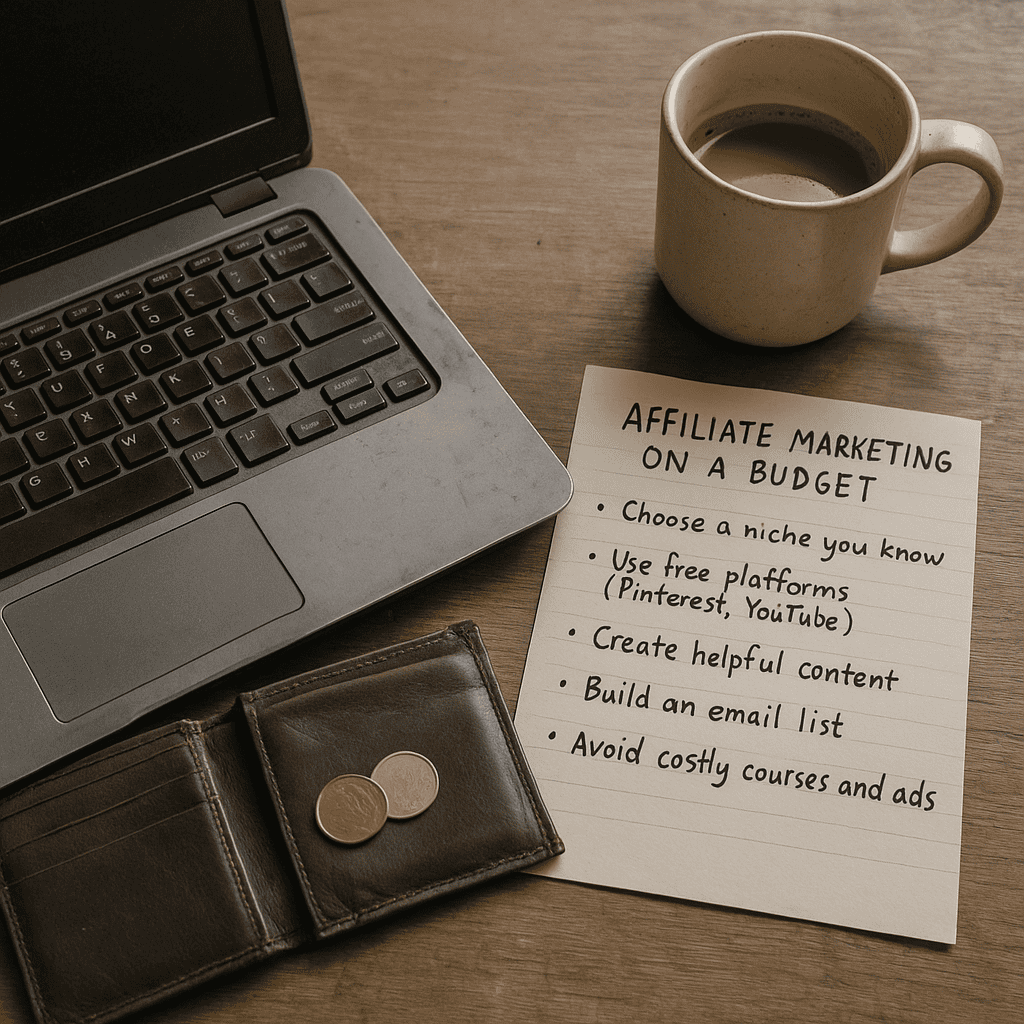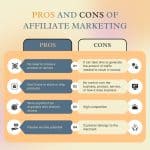How to Start Without Wasting Money
Most people think you need deep pockets to start and it’s impossible to do affiliate marketing on a budget. Spoiler: you don’t and you can. You don’t need to throw cash at fancy courses, ads, or shiny software. What you do need is a bit of focus, some free tools, and the ability to avoid the traps that make beginners broke before they’ve even started.
This is your budget survival guide to affiliate marketing on a budget.
The Money Traps Beginners Fall Into
Before we get into what works, let’s call out the usual money pits:
-
£500 “guru” courses that promise overnight riches
-
Paid ads when you don’t even know if your links will convert
-
Dozens of software subscriptions you don’t need yet
-
Buying every domain/hosting upsell like it’s Pokémon
If you’re on a budget, your job is simple: avoid wasting money and stick to what gets results for free (or close to it). f you want to see the biggest lessons I learned the hard way, check out my post on 5 Things I Wish I Knew Before Starting My Online Business
Step 1: Pick a Niche Without Paying for Expensive Tools
The number one mistake beginners make is trying to be in every niche at once. Don’t. You’ll burn out and never gain trust from anyone. The best way to start is with what you know or genuinely want to learn more about. Building trust is so much easier when you actually care about the subject.
Start by asking:
-
What do I already know about or enjoy?
-
What problems have I solved in my own life?
-
What do friends ask me for advice on?
That’s a better start than “what’s trending on TikTok.”
You don’t need pricey SEO software to check if a niche has potential. Use Google Trends to see if people are searching more or less for it. Pop a word into Pinterest or TikTok search and see if there’s content already being made. If there is, good — it means there’s an audience.
When you’ve got a shortlist, look for affiliate programs in that space. You’ll find plenty through networks like CJ Affiliate, ShareASale, ClickBank, or even directly with brands you already like.
Compare commission rates, cookie durations, and any restrictions before you commit. A 90-day cookie means more chance of getting paid than a stingy 24-hour one.
💡 Quick note: what’s a cookie?
When someone clicks your affiliate link, a tiny tracking file (a “cookie”) sits in their browser. If they buy within that time window — 24 hours, 30 days, 90 days, whatever the program offers — you get the commission. Longer cookies usually mean a better chance you’ll earn.
Step 2: Use Free Platforms to Start Affiliate Marketing On a Budget
Here’s the truth: I choose to have this website as my main stadium for my audience, but you don’t need a website to start. Would it help long-term? Yes. Do you need it right now? No.
If you really don’t have pennies to spend on a URL, you can start on free, high-traffic platforms:
-
Pinterest – brilliant if you’re sharing how-tos or blog-style content
-
YouTube – faceless videos work fine; plenty of channels earn without showing their face
-
TikTok or Instagram Reels – short bursts of helpful content
-
Medium or Reddit – more text-based, but great for some niches
Pick one or two max. A big mistake is thinking you must be everywhere. You’ll just do everything badly. Better to master one platform, get some traction, and then expand.
Step 3: Create Content That Helps, Not Hypes
Content is where trust is built (or lost). The trick isn’t spamming links — it’s being genuinely useful. That means content that solves problems.
Let’s say your niche is health and wellness. Here are a few ways you could create content:
-
Write a blog post comparing “5 Free Fitness Apps That Actually Work” and mention the one you’re an affiliate for
-
Record a YouTube Short showing “3 Easy Desk Stretches to Beat Back Pain” and link to the yoga mat or chair you actually use
-
Post a Pinterest pin with “Healthy 10-Minute Breakfasts” and link to a blender you recommend
See the pattern? You’re not just saying “buy this.” You’re solving a problem, answering a question, or making someone’s day easier. The affiliate link naturally fits inside that.
And yes, always add a disclosure:
This post contains affiliate links. If you buy through them, I may earn a commission at no extra cost to you.
It builds trust and keeps you on the right side of the law.
Step 4: Build a Free Email List (and Nurture Your Audience)
If you skip this, you’re basically building your business on rented land. Social platforms change algorithms overnight. Your email list is the only audience you own.
Start building an email list right away, even if you only send out a monthly tip. You don’t need fancy automations to begin with.
A free AWeber, MailerLite or Mailchimp plan is enough. Create one opt-in — a checklist, mini guide, or even just “weekly tips to get started.”
Then:
-
Add your link in your bio
-
Drop it casually into your content (“grab my free checklist if you’re starting out”)
-
Send short, helpful emails. Don’t overthink them
👉 Example (gardening niche): Offer a free Seasonal Planting Calendar in exchange for emails, then send weekly tips like “What to Plant This Month” or “3 Mistakes to Avoid When Starting Tomatoes.” Tie in affiliate products like compost bins, gloves, or soil testers.
Even if you only email once a month at first, you’ll be ahead of 90% of beginners. Engage with every comment, email, or question. Simple interactions can turn followers into superfans… and superfans drive sales.
Step 5: Place Links (The Right Way)
No one clicks links dumped at the end of a post with no context. Your affiliate links should feel natural, not forced. Think of them as a helpful resource tucked inside good content.
Examples:
-
A “Best Tools for Blogging” article where you link the hosting you actually use
-
A YouTube video about morning routines where you mention the journal you write in
-
A recipe blog where you link the kitchen gadgets you’ve tested
Always frame it around solving a problem. Spammy link-drops will get you ignored.
Pro tip: Use link-shortening tools like Pretty Links on WordPress. It makes your links look clean and professional (and easier to remember if you share them verbally).
Step 6: Free SEO = Long-Term Traffic
SEO (Search Engine Optimisation) sounds scary, but the basics are free and straightforward. You don’t need to be an SEO wizard. Just get the basics right:
-
Use AnswerThePublic or Ubersuggest (free version) to find questions people actually type into Google
-
Make those questions your blog titles or sub-headings
-
Write posts with clear headings, short paragraphs, and natural keyword use (like “affiliate marketing on a budget”)
-
Link to your own related posts where relevant — internal linking keeps people on your site longer
-
Update old posts every few months — Google loves fresh content
Keep paragraphs short and clear — no walls of text. For another solid breakdown of affiliate marketing basics, see HubSpot’s Affiliate Marketing for Beginners guide
Step 7: Track, Tweak, and Grow (Slowly)
The best way to blow your budget is to reinvest too early. Wait until you see steady traffic or some commissions coming in. Then upgrade bit by bit.
And don’t guess — check the numbers:
-
Use free analytics from your blog platform, YouTube, or Pinterest to see what’s driving clicks
-
Look inside your affiliate dashboard for which links are converting
-
Double down on what works. Drop what doesn’t
As you start seeing results, you can slowly reinvest — maybe £10–20/month for hosting, or a proper email service once free tiers feel limited.
Smart upgrades could include:
-
Web hosting so you own your site
-
A better email tool like AWeber (free to start, upgrade later for automations)
-
Maybe a keyword tool like Keysearch
Think of it like upgrading your bike — no point buying carbon wheels if you’ve barely learned to ride.
Bonus: Build Backlinks for Free Authority
Want Google (and people) to take you seriously? Build backlinks without spending a penny. You don’t need to pay for fancy PR. A few free methods can get you seen:
-
Guest post on small blogs in your niche
-
Answer questions on forums like Quora or FB groups and link back only when it genuinely helps
-
Network and collaborate with other small creators — even simple shout-outs or collab posts
Every little link back to your content builds authority with Google (and with real people). It’s not glamorous, but it works.
Key Takeaways
Affiliate marketing on a budget is 100% doable. So no budget? No problem. With smart strategies and persistence, anyone can start affiliate marketing.
-
Avoid the money traps
-
Focus on free platforms, helpful content, and starting an email list
-
Place links naturally — no spam
-
Reinvest only once you’ve earned something
Remember: affiliate marketing is a marathon, not a sprint. Cut the fluff, stay persistent, and genuine results WILL come. This is a long game. Stay patient, stay consistent, and your wallet will thank you.
Affiliate link awareness
Some of the links in this post are affiliate links. That means I may earn a small commission if you click through and buy — at no extra cost to you. I only recommend products I’ve actually used or genuinely find useful.
Want no-fluff tips for building your online biz?
If this post gave you a lightbulb moment or a sigh of relief, you're not alone — that's exactly why I started sharing what I've learned.
Pop your name and email below and I'll send you beginner-friendly advice, useful tools, and the truth behind what really works online — straight to your inbox, no pressure.
👇 Sign up below and let's do this together.
Affiliate Note: Some of the links above are affiliate links, which means if you decide to purchase through them, I may earn a small commission — at no extra cost to you.
I only recommend tools I truly believe in and use myself. It helps support my blog and keeps the coffee flowing ☕
💬 Over to You:
What’s one thing you wish someone had told you before starting your online business?
I'd love to hear it — just hit reply to any of my emails and tell me, or share it with me over on my Facebook page. I read every single one.
SHARE – If you found this post helpful, why not share it with someone else who’s figuring it out too?


